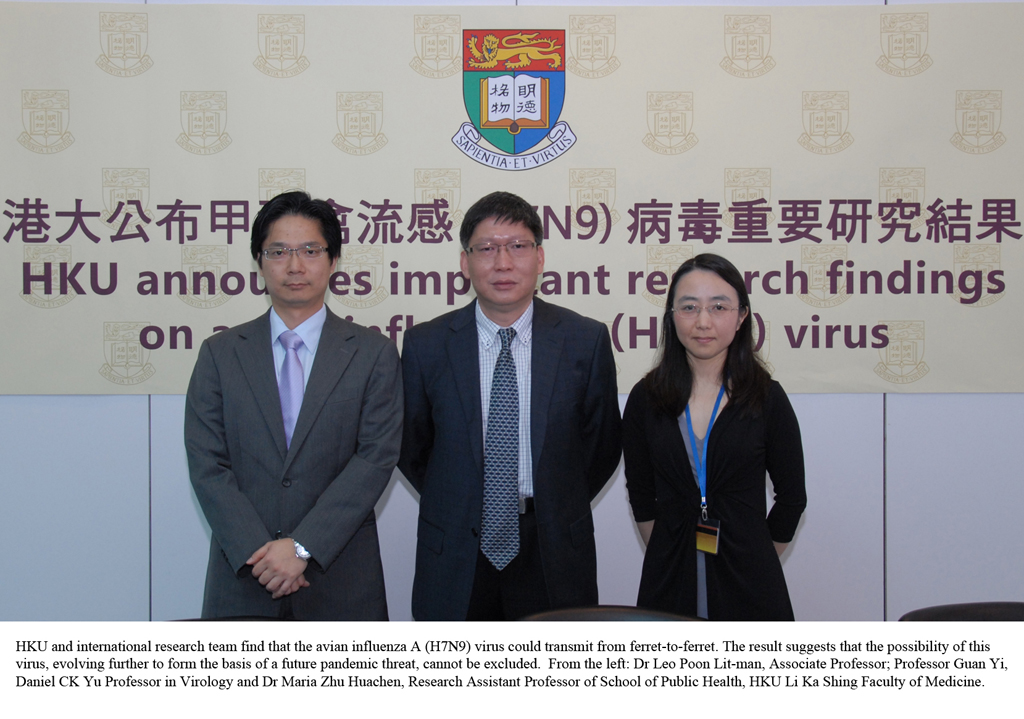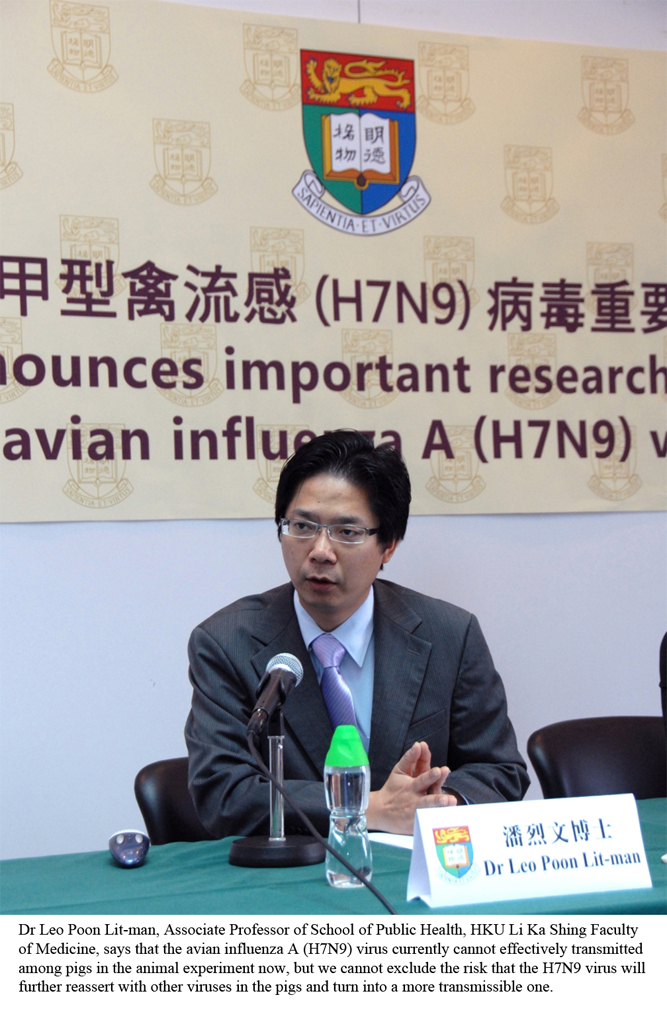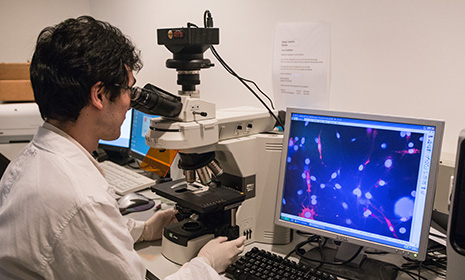HKU and international research team find human-isolated avian influenza A (H7N9) virus can transmit via close contact and air-borne exposure while it can also infect pigs, Research published in prestigious international scientific journal, Science
An international research team, led by Professor Yi Guan of School of Public Health, The University of Hong Kong Li Ka Shing Faculty of Medicine, in collaboration with the National Influenza Centre, Chinese Centre for Disease Control and Prevention, find that the human-isolated avian influenza A (H7N9) virus can cause significant infection in ferrets, the main animal model for research into human influenza, and cause clinical signs similar to those of the pandemic H1N1 2009 virus. The virus can transmit from ferret-to-ferret via close contact and air-borne exposure. The team also discovers that pigs can also be infected by the H7N9 virus, leading to mild visible clinical signs and pneumonia.
The findings suggest that the possibility of this virus, evolving further to form the basis of a future pandemic threat, cannot be excluded. This research has been published this morning in the most prestigious international scientific journal, Science.
Research Implications
The study proves that the avian influenza A (H7N9) virus can infect ferrets and cause relatively mild clinical signs. This virus can transmit via direct contact and air-borne exposure, albeit the latter less efficiently. The infected animals do not necessarily develop fever and other related clinical signs, indicating that asymptomatic infections among human are possible. As the avian influenza A (H7N9) can also infect pigs, surveillance of pigs is needed to prevent the epidemic from spreading further.
Since H7N9 virus has the possibility to infect mammals, such as human, pigs and ferrets, the research team suggests that for better disease control and prevention, the health authority should also take into consideration of other poultry and pets which may have a chance to be contacted with the virus. According to the findings, transmission of H7N9 virus via air-borne exposure is less efficient. However, high titers of virus start to be shed before symptomatic infections of animals, and atypical signs of infections may occur. Public health measures should thereby be well maintained and the possibility that this virus will evolve further to acquire human-to-human transmissibility, which could form the basis of a future pandemic threat, cannot be excluded.
Background and key research findings
To date, a total of 130 laboratory-confirmed cases of human infection with avian influenza A (H7N9) virus have been reported in mainland China since March this year. The Case of "Family Cluster" in Shanghai and Shandong aroused the awareness and concerns towards the potential risks of human-to-human transmissibility.
Professor Guan"s team, in collaboration with the National Influenza Centre, uses ferrets to test for the virus infectivity, pathology and transmissibility, which is the most accepted animal model for research into human influenza. The team finds that shedding of high titers of virus could occur within 24 hours post-inoculation, followed by clinical signs including fever, sneezing, nasal discharge, mild lethargy, cough and pneumonia. The infected ferrets normally shed virus for 5 to 7 days. Since day 7 post-inoculation, specific antibodies against the H7N9 virus appear in the ferret serum, and viruses in the lungs and other organs are gradually cleared. Infected ferrets fully recover at 14 to 16 days post-inoculation. In general, the avian influenza A (H7N9) virus could cause clinical profiles and virus shedding kinetics similar to those of the pandemic H1N1 2009 virus.
Further study on the animal test shows that ferrets placed in close contact with those already infected ferrets will also become infected and they can achieve limited infection via airborne exposure. The transmissibility of H7N9 is less efficient than that of H1N1 2009 virus.
On the other hand, the study unveils that pigs can also be productively infected by the H7N9 virus, leading to mild visible clinical signs and pneumonia. However, sustained transmission is not observed among pigs via close contact or airborne exposure.
About the research team
This research was led by Professor Yi Guan, Daniel C K Yu Professor in Virology, Professor of School of Public Health, the Director of State Key Laboratory of Emerging Infectious Diseases, The University of Hong Kong Li Ka Shing Faculty of Medicine and Professor Shu Yuelong, the Director of National Influenza Centre, Chinese Centre for Disease Control and Prevention. This international research team also includes research members from The University of Hong Kong, Shantou University Medical College, Shenzhen Third People"s Hospital, St Jude Children"s Research Hospital (USA) and University Health Network (Canada). The influenza research team continues to make contributions to combat emerging infectious diseases.













.png)
